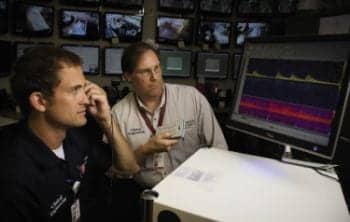In a recent industry report, Market Study researchers estimate the global market for artificial intelligence (AI) in healthcare will reach at least $10 billion by 2024.
That number is based on projections of a whopping 40% compound annual growth rate, to be driven, experts say, by an anticipated surge in demand for cognitive computing, advanced machine learning, and predictive analytics.
This is great news for a company like Glassbeam, a Santa Clara, Calif.-based developer of an AI/ML platform that employs advanced analytical frameworks to evaluate reams of “unstructured data,” such as physicians notes and radiology reports, to spot trends, good or bad, using predictive analytics.
Below, Puneet Pandit, the founder and CEO of Glassbeam, shares his thoughts on the evolution of the company and how machine data analytics can help a hospital improve the uptimes of its medical devices.
24×7 Magazine: As founder and CEO, can you please tell us a little about your impetus for launching your company and how it has evolved?
Puneet Pandit: Glassbeam was launched as a brand in 2009 inside an IT services company with the mission of helping product companies make sense of complex machine data collected from connected devices. It was during the early days of machine data analytics and the Internet of Things (IoT) was still an emergent trend. It was relaunched as a pure SaaS offering on AWS in 2014 catering exclusively for the industrial IoT market.
Glassbeam’s founding team had come from diverse and experienced backgrounds—from working with leading storage networking companies, such as NetApp and Brocade, to un-covering the untapped potential of call-home and phone-home log data. The team firmly believed that any high technology machine, system, or device—whether located in a data center or in the field, such as storage, servers, MRI, CT Scan, CNC machines, and industrial robots—would become increasingly connected to their manufacturer’s home base. These complex logs, if parsed and analyzed effectively, would have an immense business and operational value for support, services, engineering, sales, and marketing groups of organizations.
Glassbeam was born with this objective: To create a generic, cloud-based platform that could ingest, parse, structure, and analyze complex machine data and provide cross-functional application and use cases for end-users within the expanding ecosystem of a product manufacturer. The company and solution have since evolved dramatically and has cornered a sweet spot in the healthcare vertical as an AI/ML platform to become more sophisticated, while at the same time, much more user-friendly.
24×7: Who are Glassbeam’s customers and how do they benefit from using your technology?
Pandit: While Glassbeam has several large Fortune 500 companies in the technology vertical, such as IBM, Dell EMC, Dimension Data and PTC, a new focus for the company is now within the healthcare vertical with three primary segments—original equipment manufacturers (OEMs), independent sales organizations (ISOs), and healthcare providers—each of which has a slightly different value proposition.
For OEMs, Glassbeam’s machine data analytics platform can have an enterprise-wide impact across different parts of the organization, such as support, engineering, sales, product, marketing, supply chain, and more. Anywhere there is a need to make a data-driven decision leveraging machine signals coming from an end user site, Glassbeam has proven business impact for OEMs with its analytics offerings.
Specifically, in support and services organizations, the lack of proactive analysis on machine logs can cause substantial delays in solving customer escalations. Without such an analysis, it is extremely difficult to identify the root cause of device performance and to track device performance. This is where Glassbeam’s predictive analytics can play a key role in identifying a potential issue within a medical device, therefore, saving time and money for both the manufacturer and the customer while also increasing the quality, consistency, and efficiency of medical equipment in support of patient care. Manufacturers have the potential to become advocates for operational effectiveness, helping providers deploy best practices throughout the delivery of services.
We are currently working with various OEMs, such as Siemens Healthineers, GE Healthcare, and VytronUS. A common theme across all these customers is the deep value we can derive from the complex logs collected from their installed base for various modalities, such as ultrasound, CT scanners, and cath labs.
With Glassbeam, ISOs are able to offer better, less expensive service options, by being proactive and predictive rather than reactive. ISOs can add a great deal of value to their service contracts and compete more effectively in the market by offering machine data analytic solutions. Remote monitoring capabilities enable ISOs to upsell into existing healthcare organizations as customers and go deeper and wider into their installed base versus the vastly more expensive need to secure new customers. It also allows ISOs to become the healthcare organization’s first line support staff and “trusted advisors” with complete access to a unified machine maintenance record. There are many cost-containment issues in today’s world of healthcare, making ISOs an ideal solution for healthcare providers that are seeking affordable options. Improved insights create opportunities for ISOs to provide additional services to healthcare organizations, such as managing their spare parts inventory and service delivery chain. Glassbeam works with several ISO partners across the country including Browns Medical Imaging, Radiographic Equipment Services (RES), Calamed, and Sound Imaging.
For healthcare providers, Glassbeam provides rich preconfigured dashboards powered with AI and ML algorithms on information related to service management and asset utilization. Our solution provides clinical engineering groups with a complete fleet management solution to manage multimodality and multi-manufacturer views, all in a single pane of glass. With this help, service engineers are able to search for a variety of metrics per machine with great ease. They are able to get predictive notifications on potential failures along with recommendations on how to solve such issues. Integrating Glassbeam analytics with CMMS information enhances the business value of machine data in understanding key metrics such as MTTR and MTBF. Managing your machine regularly is imperative to its efficiency and with Glassbeam, the service management process is greatly enhanced. For example, a healthcare facility can have the ability to understand the frequency of different tests performed in order to optimize device features for more accurate and faster results.
Glassbeam today has hundreds of medical imaging machines under their contract across 45 facilities nationwide with leading healthcare providers, such as Novant Health, Gateway Diagnostic Imaging, UCSF Medical, New Hanover Regional Medical Center, Scripps Health, Eisenhower Imaging, and Community Orthopedic Medical Group.
24×7: How does machine data analytics help a hospital improve the uptimes of its medical devices?
Pandit: As medical devices have become increasingly connected, the role of predictive analytics has become important to keeping them up and running in order to provide the best patient care and maximize revenues. Consider a healthcare provider with five MRI machines that each run one procedure per hour and five CT scanners that run each run two CT procedures per hour. And assume those machines are operating 10 hours per day, six days per week, with 96% uptime (which is 12.5 downtime days per machine per year, excluding planned downtime). Over three years of using Glassbeam analytics solution, that provider could increase uptime to 99.5%, recover nearly $5.3 million in revenue, and save more than $1.3 million in costs by optimizing service contracts. A larger provider with double the number of machines and 12 operating hours per day could save more than $12.6 million in recovered revenue, with cost savings of more than $2.6 million.
One of the driving forces behind this proactive machine maintenance is machine-learning based anomaly detection. With the help of an ML-based anomaly detection solution, a medical device operator can easily spot problems and take corrective actions. Earlier this year, we were proud to announce that Glassbeam had successfully built AI applications powered by ML models for predicting parts failures in the expensive imaging modalities. With this part failure machine-learning model, healthcare providers now have the ability to deliver better and more efficient healthcare. This model also can positively impact businesses by changing the overall way equipment maintenance is performed today by in-house staff at healthcare providers, ISOs, and OEMs.
24×7: In what ways can the AI/ML solution from Glassbeam provide cost savings to healthcare organizations?
Pandit: Medical devices are expensive due to their complexity and therefore expensive to maintain. They are engineered by combining many different components that are prone to failure and will need to be replaced multiple times during the lifetime of the device. Some parts fail due to wear and tear from normal usage; however, parts also often fail due to abnormal usage or varying environmental conditions. For example, a part may overheat and breakdown due to high usage or a part may break down because the cooling system is not functioning correctly.
Machine learning makes it easy to detect anomalies in sensor readings recorded by a device.
With the help of an ML-based anomaly detection solution, a medical imaging device operator can easily spot problems and take corrective actions. They can fix issues before those become bigger issues and cause expensive parts to fail, rendering a system unusable. By predicting part failures, healthcare organizations can prevent unplanned downtime and expensive repairs, thus maximizing the revenue and providing better patient care. By predicting a part failure via our machine learning models, a facility has the ability to be warned ahead of a machine failure. Thanks to the machine learning models, facilities have the capability to improve their equipment maintenance and productivity.
For example, a CT scanner has sensors for monitoring tube temperature, water temperature, fan speed, air temperature, water flow, and other important variables. Each sensor periodically records its readings, which can be used to determine whether the tracked variable is in the normal range. However, it is difficult to accurately identify which sensor readings are in the normal range and which are not. Currently, these thresholds are manually defined, often leading to misclassified normal values as abnormal and vice-versa. Missing an abnormal sensor reading means missing an opportunity to take corrective action in time. As a result, a problem may go unnoticed resulting in the failure and replacement of an expensive part.
24×7: As an expert in the field, how big of a role do you see AI/ML playing in the future of healthcare?
Pandit: The healthcare industry has earned a reputation of operating behind the curve when it comes to the adoption of AI/ML to gain ongoing performance improvement and cost reductions. Harbor Research, a leading strategy, and technology research firm, notes utilizing AI/ML to leverage complex machine data from healthcare imaging equipment alone will provide $11.1 billion in revenue value (decreased costs/increased revenue generation) by 2022. In fact, the FDA recently issued a report that focused on the quality, safety, and effectiveness of servicing of medical devices, highlighting the value that machine data can provide regarding performance. The report notes that among its priorities for the FDA’s Center for Devices and Radiological Health (CDRH) is the establishment of “collaborative communities” composed of public and private sector members that should work together to address the challenges associated with delivering high-quality, safe and effective servicing of medical devices. Sharing of machine data and the insights solutions, such as what Glassbeam generates, are a cornerstone of these communities.
There is no denying the critical role that AI and ML technology are currently playing throughout healthcare. Its role will only become more significant as technology advances. Machines will continue to evolve to higher levels of intelligence and connectivity, enabling new compound applications. As these devices become more complex, so too will the challenge of extracting meaningful intelligence from machine data, only possible by implementing sophisticated AI/ML solutions. Machine data will continue to play a critical role of more effective and efficient support, but future technology will need to learn to address the growing amount of complex data produced from medical devices and machines. Given all of this, I am very bullish about AI/ML’s role in the future of healthcare, not only for healthcare organizations but also for overall patient care.






